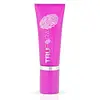What's inside
What's inside
 Key Ingredients
Key Ingredients

 Benefits
Benefits

 Concerns
Concerns

 Ingredients Side-by-side
Ingredients Side-by-side

Water
Skin ConditioningPropanediol
SolventCaprylic/Capric Triglyceride
MaskingCocoyl Adipic Acid/Trimethylolpropane Copolymer
Diisostearyl Dimer Dilinoleate
EmollientCaprylyl Caprylate/Caprate
EmollientCandelilla/Jojoba/Rice Bran Polyglyceryl-3 Esters
EmulsifyingGlyceryl Stearate
EmollientIsononyl Isononanoate
EmollientButyrospermum Parkii Butter
Skin ConditioningGlycerin
HumectantBentonite
AbsorbentBehenyl Alcohol
EmollientPyrus Malus Fruit Extract
Skin ConditioningRibose
HumectantStearyl Alcohol
EmollientCetearyl Alcohol
EmollientEthylhexyl Isononanoate
EmollientSodium Stearoyl Lactylate
EmulsifyingOryza Sativa Bran Extract
Skin ConditioningPanthenol
Skin ConditioningGlycine Soja Extract
Skin ConditioningXanthan Gum
EmulsifyingGlycine Soja Sterols
EmollientLinoleic Acid
CleansingPhospholipids
Skin ConditioningEthylhexylglycerin
Skin ConditioningChondrus Crispus Extract
Skin ConditioningYeast Extract
Skin ConditioningHelianthus Annuus Seed Oil
EmollientPotassium Sorbate
PreservativeHydrolyzed Viola Tricolor Extract
Skin ProtectingAloe Barbadensis Leaf Extract
EmollientAvena Sativa Kernel Flour
AbrasiveCitric Acid
BufferingAlaria Esculenta Extract
Skin ProtectingTrisodium Ethylenediamine Disuccinate
Avena Sativa Kernel Extract
AbrasiveRosmarinus Officinalis Leaf Extract
AntimicrobialVitis Vinifera Juice Extract
AntioxidantTocopherol
AntioxidantSodium Hyaluronate
HumectantSophora Japonica Flower Extract
Skin ProtectingWater, Propanediol, Caprylic/Capric Triglyceride, Cocoyl Adipic Acid/Trimethylolpropane Copolymer, Diisostearyl Dimer Dilinoleate, Caprylyl Caprylate/Caprate, Candelilla/Jojoba/Rice Bran Polyglyceryl-3 Esters, Glyceryl Stearate, Isononyl Isononanoate, Butyrospermum Parkii Butter, Glycerin, Bentonite, Behenyl Alcohol, Pyrus Malus Fruit Extract, Ribose, Stearyl Alcohol, Cetearyl Alcohol, Ethylhexyl Isononanoate, Sodium Stearoyl Lactylate, Oryza Sativa Bran Extract, Panthenol, Glycine Soja Extract, Xanthan Gum, Glycine Soja Sterols, Linoleic Acid, Phospholipids, Ethylhexylglycerin, Chondrus Crispus Extract, Yeast Extract, Helianthus Annuus Seed Oil, Potassium Sorbate, Hydrolyzed Viola Tricolor Extract, Aloe Barbadensis Leaf Extract, Avena Sativa Kernel Flour, Citric Acid, Alaria Esculenta Extract, Trisodium Ethylenediamine Disuccinate, Avena Sativa Kernel Extract, Rosmarinus Officinalis Leaf Extract, Vitis Vinifera Juice Extract, Tocopherol, Sodium Hyaluronate, Sophora Japonica Flower Extract
Water
Skin ConditioningRosa Damascena Flower Water
MaskingGlycerin
HumectantCaprylic/Capric Triglyceride
MaskingSesamum Indicum Seed Oil
EmollientCetyl Alcohol
EmollientHydroxyethyl Acrylate/Sodium Acryloyldimethyl Taurate Copolymer
Emulsion StabilisingPrunus Amygdalus Dulcis Oil
Skin ConditioningRosa Damascena Flower Oil
MaskingSodium Hyaluronate
HumectantHydroxyacetophenone
AntioxidantPhenoxyethanol
PreservativePrunus Armeniaca Kernel Oil
MaskingButyrospermum Parkii Butter
Skin ConditioningTocopheryl Acetate
AntioxidantHydroxyethyl Urea
HumectantDisodium EDTA
Sodium Ascorbyl Phosphate
AntioxidantBeta-Carotene
Skin ConditioningWater, Rosa Damascena Flower Water, Glycerin, Caprylic/Capric Triglyceride, Sesamum Indicum Seed Oil, Cetyl Alcohol, Hydroxyethyl Acrylate/Sodium Acryloyldimethyl Taurate Copolymer, Prunus Amygdalus Dulcis Oil, Rosa Damascena Flower Oil, Sodium Hyaluronate, Hydroxyacetophenone, Phenoxyethanol, Prunus Armeniaca Kernel Oil, Butyrospermum Parkii Butter, Tocopheryl Acetate, Hydroxyethyl Urea, Disodium EDTA, Sodium Ascorbyl Phosphate, Beta-Carotene
Ingredients Explained
These ingredients are found in both products.
Ingredients higher up in an ingredient list are typically present in a larger amount.
This ingredient is also known as shea butter. It is an effective skin hydrator and emollient.
Emollients help soothe and soften your skin. It does this by creating a protective film on your skin. This barrier helps trap moisture and keeps your skin hydrated. Emollients may be effective at treating dry or itchy skin.
Shea butter is rich in antioxidants. Antioxidants help fight free-radicals, or molecules that may harm the body. It is also full of fatty acids including stearic acid and linoleic acid. These acids help replenish the skin and keep skin moisturized.
While Shea Butter has an SPF rating of about 3-4, it is not a sunscreen replacement.
Shea butter may not be fungal acne safe. We recommend speaking with a professional if you have any concerns.
Learn more about Butyrospermum Parkii ButterThis ingredient is an emollient, solvent, and texture enhancer. It is considered a skin-softener by helping the skin prevent moisture loss.
It helps thicken a product's formula and makes it easier to spread by dissolving clumping compounds.
Caprylic Triglyceride is made by combining glycerin with coconut oil, forming a clear liquid.
While there is an assumption Caprylic Triglyceride can clog pores due to it being derived from coconut oil, there is no research supporting this.
Learn more about Caprylic/Capric TriglycerideGlycerin is already naturally found in your skin. It helps moisturize and protect your skin.
A study from 2016 found glycerin to be more effective as a humectant than AHAs and hyaluronic acid.
As a humectant, it helps the skin stay hydrated by pulling moisture to your skin. The low molecular weight of glycerin allows it to pull moisture into the deeper layers of your skin.
Hydrated skin improves your skin barrier; Your skin barrier helps protect against irritants and bacteria.
Glycerin has also been found to have antimicrobial and antiviral properties. Due to these properties, glycerin is often used in wound and burn treatments.
In cosmetics, glycerin is usually derived from plants such as soybean or palm. However, it can also be sourced from animals, such as tallow or animal fat.
This ingredient is organic, colorless, odorless, and non-toxic.
Glycerin is the name for this ingredient in American English. British English uses Glycerol/Glycerine.
Learn more about GlycerinSodium Hyaluronate is hyaluronic acid's salt form. It is commonly derived from the sodium salt of hyaluronic acid.
Like hyaluronic acid, it is great at holding water and acts as a humectant. This makes it a great skin hydrating ingredient.
Sodium Hyaluronate is naturally occurring in our bodies and is mostly found in eye fluid and joints.
These are some other common types of Hyaluronic Acid:
Learn more about Sodium HyaluronateWater. It's the most common cosmetic ingredient of all. You'll usually see it at the top of ingredient lists, meaning that it makes up the largest part of the product.
So why is it so popular? Water most often acts as a solvent - this means that it helps dissolve other ingredients into the formulation.
You'll also recognize water as that liquid we all need to stay alive. If you see this, drink a glass of water. Stay hydrated!
Learn more about Water